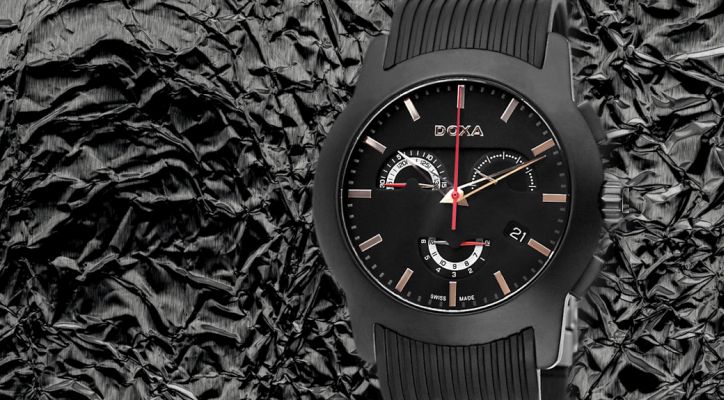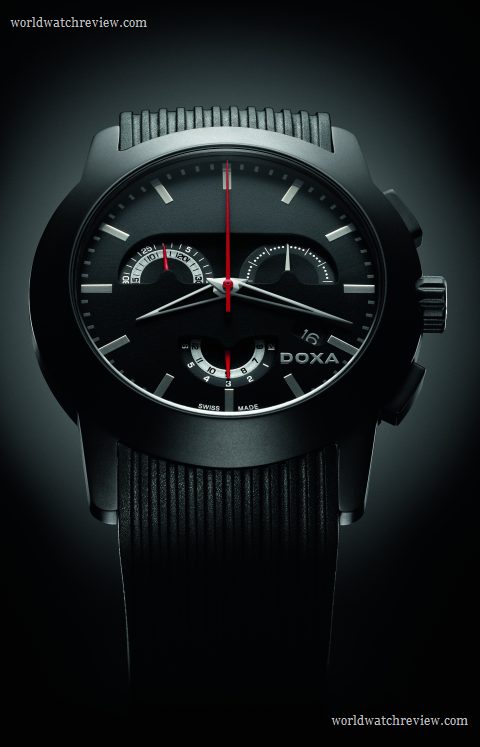
With its quartz Grafic Mistero (ref. 359.10S.101.20) chronograph, DOXA makes the first step into the uncharted territory of relatively inexpensive timepieces that come in a deliberately “un-Doxa” hi-tech exterior.
Definitely, Bauhaus in its design approach, the new DOXA Grafic Mistero tries to find a perfect balance between the outrageously high-tech Porsche Design Worldtimer P’6750 and the recently introduced Vogard Datezoner automatic chronograph that costs like a German luxury sedan.
From the former, it borrows the clean lines and contempt to excessive embellishments. From the latter, it takes the car dashboard-style layout for its laconic dial.
Both hour and minute chronograph totalizers as well as the small seconds sub-dial (located at 6, 9, and 3 o’clock respectively) are only partly visible through a pair of cut-outs in the upper and lower parts of the dial.

Thanks to this kind of design, the layout looks not as busy as most chronographs do, while at the same time preserving superb usability. Judging by the looks of it, the hands (or rather ‘pointers’) on the sub-dials are stationary while the disks with infinitesimally small Arabic numerals are rotating around their axes.
The only thing that bothers me a little is the way that they decided to place the small DOXA logo.
For some unknown reason, initially, the emblem was put between 4 and 5 o’clock, right below the date aperture, visually tilting the design of the dial off-balance, but was later moved back to a more familiar place at 12 o’clock. The only explanation that comes to mind is that they simply wanted to make the dial look cleaner and thus removed any visual distractions from the “dashboard”.
Since DOXA apparently wanted the Grafic Mistero to be relatively affordable, they decided to use a fairly inexpensive mechanism to power it. I don’t see it as a problem though. The Ronda 5030.D caliber that powers it is known for its high accuracy and good build quality: after all, it is the very same movement that also happens to animate the semi-pro CX Swiss Military Argonaut 1000 TQ diving instrument that is twice more expensive than this “lifestyle” timepiece.
According to the Swiss company’s press release, the watch will arrive in two versions: one in a circular-shaped 44 mm black steel case (pictured) and the other in a 40 mm x 43 mm rectangular stainless steel body.
No info on the price yet, but I can guess that it will cost around the €1000 mark. Frankly, I am not sure that this attempt of diversification will be successful: after all, DOXA is primarily associated with professional diving tools and, to a lesser degree, with classic-styled dressy timekeepers. While they attract a certain amount of young customers looking for their first “real” watch, this inexpensive quartz model can actually hurt the brand’s perception as a maker of “serious” divers.
See also: Victorinox Swiss Army Alliance Chronograph 241478
Photos: DOXA
DOXA Grafic Mistero Quartz Chronograph (ref. 359.10S.101.20) specification
Movement: Quartz, caliber Ronda 5030.D, Swiss Made
Functions: Hours, minutes, small seconds, chronograph, date
Case: Black IP steel
Shape: Round
Size: 44.00 mm
Dial: Black
Hands: Steel, skeletonized
Water resistance: 50 meters
Strap: Black rubber
Crystal: Sapphire, antireflective
Back: Solid
